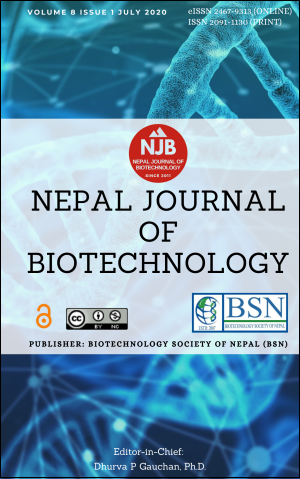Phenolic Compounds from the Aerial Parts of Adenophora triphylla (Thunb.) A. DC. var. triphylla and their Free Radical Scavenging Activity
DOI:
https://doi.org/10.3126/njb.v8i1.30205Keywords:
Adenophora triphylla, Saiyousyajin, phenolic compound, free radical scavengingAbstract
Adenophora triphylla (Thunb.) A. DC. var. triphylla (Family: Campanulaceae) is distributed in Japan, Korea, and China. It is locally known as “Saiyousyajin” in Japan and the roots are used in traditional medicine to treat chronic bronchitis and whooping cough, and also as anti-inflammatory and anti-tussive agents. Till now, there is no report on the chemical constituents of aerial parts. Thus, the main aim of this study was to isolate and identify major chemical constituents of aerial parts of A. triphylla var. triphylla, and to evaluate their free radical scavenging activity. The 70% methanol extract of the aerial parts was subjected to repeated column chromatography using MCI gel CHP-20P, Sephadex LH-20, ODS and silica gel columns to isolate the five phenolic components (1-5). Free radical scavenging activity of the extract and compounds was evaluated using 1,1-diphenyl-2-picrylhydrazyl (DPPH) free radical scavenging activity method. The structures of the isolated compounds were elucidated as luteolin (1), luteolin 4’-O-b-glucopyranoside (2), luteolin 7-O-b-glucopyranoside (3), luteolin 7-O-neohesperidoside (4) and chlorogenic acid (5) based on their nuclear magnetic resonance (NMR) spectral data and comparison with literature values. All these compounds were isolated for the first time from A. triphylla var. triphylla. Extract showed weak free radical scavenging activity. Among isolated compounds, luteolin (1), luteolin 7-O-b-glucopyranoside (3), luteolin 7-O-neohesperidoside (4) and chlorogenic acid (5) showed potent free radical scavenging activity. Results from this study suggest that the aerial parts of A. triphylla var. triphylla might be a potential plant source for the development of functional foods, however further detailed research is necessary.
Downloads
Downloads
Published
How to Cite
Issue
Section
License
Copyright Notice:
The manuscript submitted to NJB must be an original contribution, not previously published and should not be under consideration for publication elsewhere. When the manuscript is accepted for publication, the authors agree to automatically transfer the copyright of the article to the publisher. It should grant permission to any third party, in advance and in perpetuity, the right to use, reproduce or disseminate your article, according to the NJB copyright and license agreement.
Authors transfer copyright to the publisher as part of a journal publishing agreement but have the rights to: Share their article for Personal Use, Internal Institutional Use and Scholarly Sharing purposes, with the NJB applies the Creative Commons Attribution-NonCommercial CC BY-NC license to all the works we publish after Jun 2020 (Before it was CC BY-NC-ND). Under this license, authors agree to make articles legally available for reuse, without permission or fees, for virtually any non-commercial purpose. Anyone may remix, adapt, and build upon your work non-commercially, and although their new works must also acknowledge you and be non-commercial, they don’t have to license their derivative works on the same terms. More details on CC BY-NC refer to its Licence Deed and Legal Code.






